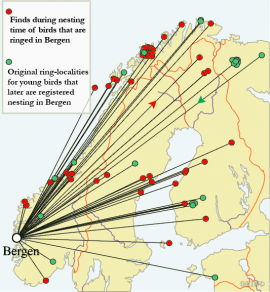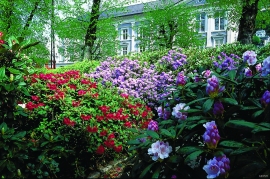Published: 10.06.2015 | Author: Stein Byrkjeland
It isn't true that hungry students have hunted down basking ducks in the city park Byparken in their spring fervour, as rumours may have it. But, it is not unusual to see students throw themselves over the park's wild birds, and hold on to them tight. They ring the birds. Because of this, we know quite a lot about the birds in Byparken.
Bird life in Byparken (the City Park) is richest in the winter. Then, it is hardest to find food, so the city is attractive with its food that passers-by strew around.
Birds that do not like bread find little in Byparken to tempt them. But, birds cannot live by bread alone. This would probably give them stomach troubles. When nesting time nears, the birds need protein-rich animal food in order to produce their eggs. There is not much of this in Byparken. While during colder periods in winter there can be well over a thousand Mallard Ducks at one time by Smålungeren, it can be as good as empty toward the end of April. These Mallards are for the most part local nesting birds. A birdcount in 1983 showed that there were about 460 pairs of Mallards on the Bergen peninsula. Many of them seek shelter in the city parks in winter.
Among the most numerous birds in the Byparken are the gulls; Common Gulls and Herring Gulls are the most common. Even though both are common nesting birds along the coastal rocks in Hordaland, most of the gulls in Byparken come from other areas. Many hundreds of Common Gulls in Byparken get ringed. A number of them have later been discovered in Finland and Sweden, some also in Russia. There are some that come back year after year. One Common Gull that Alf Tore Mjøs ringed in Byparken 24/11/1984 was documented at the same place on 13.1.2000 - just as healthy and fit. That says a lot about the gulls' life expectancy, and a bit about the bird-ringer's, also.
The North American Ring-billed Gull strongly resembles the Common Gull, and therefore often gets misidentified. Each year, some Ring-billed Gulls make their way to Europe. It is thought that these birds got blown off course by the wind over the Atlantic Ocean - and therefore lost their way in the big world. A total of 20 out of the 24 Norwegian sitings of this species were made in Byparken after it was first discovered in 1982. Several have returned to Bergen the following winter. That a tourist that first has seen Bergen, returns whenever they get the chance, is only to be expected.
Map showing where the Herring Gulls that overwinter in Bergen, originate. (Alf Tore Mjøs/ Eva Bjørseth)
Rhododendron
With its acidic soil and mild climate, Bergen is an ideal place for rhododendron. This evergreen plant with its glamorous blossoms came into fashion in Bergen's merchants'- and shop owner's gardens in the 1880's. In 1987, Bergen got named “Rhododendron's City”, and a few years later the world's first "rhododendrarium" became a reality. Most rhododendrons come from the Himalaya region, but the most common in Bergen, R. catawbiense, originated inAmerica. All together, there are over 20 000 hybrids of this plant.






